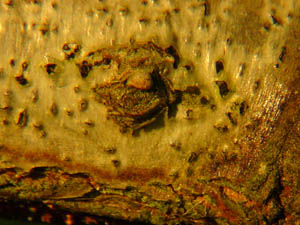Redosier Dogwood Canker | |
|---|---|
| July 3, 2007 | |
|
You do not have to look long and hard this year to see dieback in redosier dogwood shrubs. This is the plant you may know as redtwig or yellowtwig dogwood. The species I learned is Cornus stolonifera, but the name is now Cornus sericea. The problem evident now is Botryosphaeria canker, caused by a fungus called Botryosphaeria dothidea. As with most cankers, the fungus invades through wounds, possibly growth cracks, and weak areas of the wood. This species may also infect lenticels. Lesions develop on the wood, quite noticeable as a dark area of the bark. The lesion may grow to encircle the stem, killing the cambium as it progresses. The girdled stem dies from the canker to the tip of the stem. The image shows the type of dieback evident now in the redtwig cultivar of redosier dogwood.  Why are redosier dogwoods affected while other plants are not? Actually, other plants may also be affected, but the red or yellow color of the redosier stems shows damage more readily. Both freezing and drought predispose plants to the opportunistic fungi that cause cankers and stem dieback, so possibly the redosier dogwoods are more sensitive than other species. Plants deacclimate from winter hardiness slowly as spring temperatures rise. When a late frost occurs, as it did in early April this year, plant tissues are injured. According to Sinclair, Lyon, and Johnson in Diseases of Trees and Shrubs, “sapwood, cambium, and phloem tissues deacclimate to different degrees.” The sapwood is least tolerant of cold, so it freezes first. Sapwood or cambium injury leads to cankers. Obviously, our spring weather pattern was conducive to the formation of cankers. Drought stress may also lead to Botryosphaeria canker in redosier dogwoods, and there was a long stretch of drought stress last summer. I saw Botryosphaeria canker on my redosier dogwoods last fall. Others appeared this spring. To confirm a fungal canker, look for fruiting bodies of the fungus in the lesions. They appear as black, pinhead-sized structures embedded in the face of the lesion, as seen in the image.  Go with your first instincts for disease management of redosier cankers. Remove dead wood during dry weather, water the roots in periods of drought stress, mulch to conserve soil moisture, and remove the oldest stems each fall. Fungicides do not help this situation. For more on canker diseases, consult Report on Plant Disease, no. 636, “Canker and Dieback Diseases of Woody Plants,” available at http://www.ag.uiuc.edu/~vista/horticul.htm or in your local Extension office. |